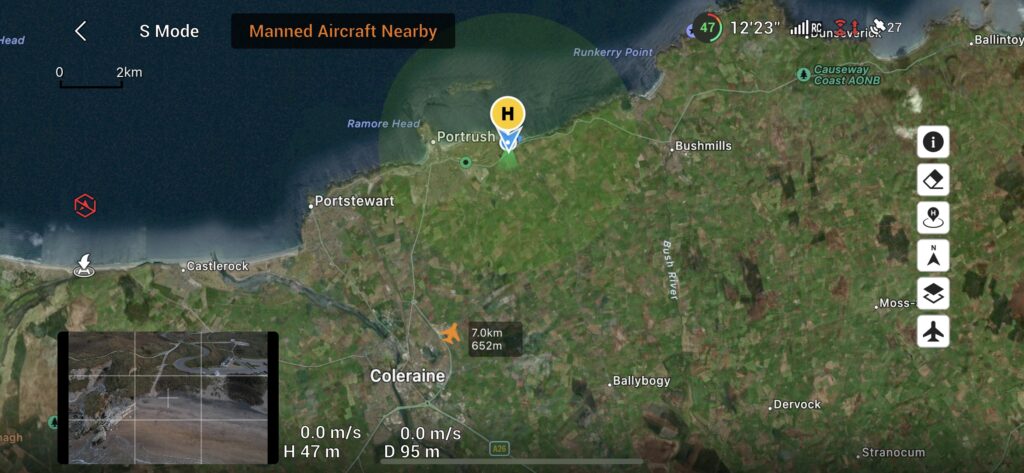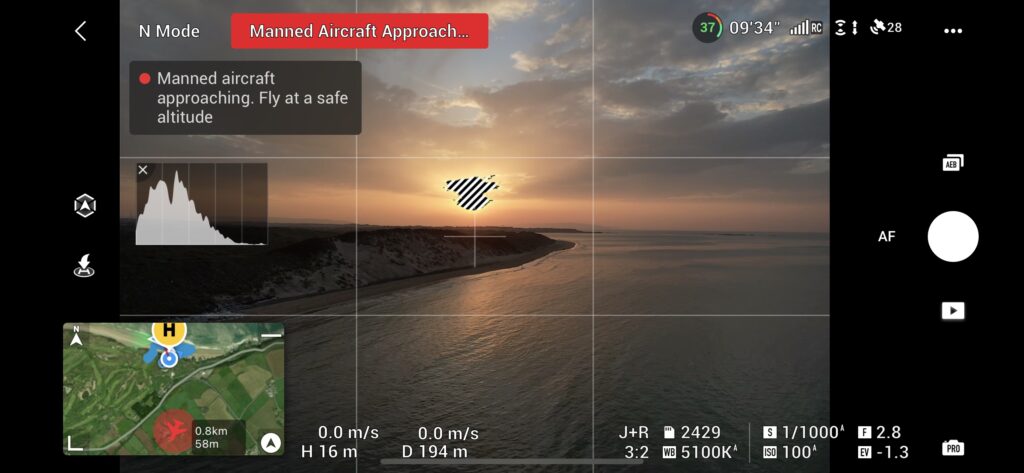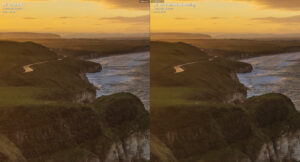What is Airsense?
DJI Airsense is a situational awareness aid that is built into the DJI Fly app. As drone pilots and landscape photographers we need to monitor the environment around us constantly. Other people, the weather and bird life are just some of the factors we need to consider as we fly. However, the most important consideration from a safety perspective is the threat drones pose to other aircraft. DJI Airsense detects ADS-B transmissions from manned aircraft which have the appropriate equipment installed and helps you to avoid collisions.
Does Airsense detect all aircraft?
Depending on where in the world you are based, aircraft may or may not be obliged to have this equipment. Unfortunately, as of June 2022, it is not a requirement here in the United Kingdom or Ireland. Most of the aircraft I encounter while enjoying aerial landscape photography do not have this equipment and I have to rely on my senses of sight and hearing to ensure I fly safely. I was therefore quite excited to see the DJI Airsense system in action recently when flying on the north coast of Ireland.
What do Airsense alerts look like?

As I flew 47m (154ft) over the water at Whiterocks Beach, Portrush, I received a flashing amber ’Manned Aircraft Nearby’ warning within my DJI Fly app. Touching this alert brought up the map you see above, on which the manned aircraft’s position can be clearly seen north west of the town of Coleraine. You will see that is was at an altitude of 652m (2,139ft) and 7km (4.35 miles) away from me. However, DJI Airsense also indicates the aircraft’s direction of travel and I noted it was flying towards the coast. Helpfully, the view from the drone camera can also be seen when looking at the map
What should I do when I get an Airsense alert?
Although the aircraft was 7km away, prompt action was needed to ensure my drone was not a threat to the aircraft. I immediately switched my DJI Air 2s drone into sport mode and executed a rapid descent to 16m (52ft). If you fly the drone straight down the descent speed is limited – this is because if the drone drops too quickly it will not be able to maintain lift when it enters its own downdraft and would crash. If you introduce lateral movement (e.g. flying forward) while you descend, the drone can descend at a significantly greater rate.

Within just a few minutes the amber alert turned to a red ’manned aircraft approaching’ alert. I was surprised at how quickly the aircraft, a Eurocopter helicopter, had covered the initial 7km distance. It was now 0.8km (1/2 mile) away and at an altitude of 58m (190ft). I was glad I had taken the precautionary step of descending to a safe altitude when I knew the aircraft was potentially coming my way. Although it didn’t come any closer to me than this, it could well have. If I had ignored the Airsense warning or delayed my reaction to it then a dangerous situation may have developed. Researching this type of helicopter later I noted that it had a top speed of 268km/h. Given that I was first alerted when it was 7km away, the simple mathematics shows that at this stage the helicopter was potentially less than 2 minutes flight time away.
The importance of situational awareness
When you fly, make sure you are always watching and listening to what is going on around you. As I mentioned at the start of this article, most aircraft do not show up on Airsense yet. So, anytime I hear an aircraft coming I immediately descend to a safe altitude and land as soon as it is safe and appropriate to do so. In this case however, the amazing DJI Airsense system ensured that both I and the helicopter pilot could operate safely.
DJI Drone Rapid Descent Procedure
It is important to become competent in controlling your drone and I would recommend the following as a rapid descent procedure (*) for DJI drones:
- Switch to your drone’s fastest decent mode (typically normal or sport mode) and angle the camera downwards to 45-60 degrees. If normal and sport mode have the same descent rate on your drone (check the specs online), stick with normal mode to maintain the function of the collision sensors.
- Identify and turn towards the safest space within your flight environment. This will typically be an area with no people/buildings. If you are a more advanced drone pilot you may feel confident enough to spiral downwards as you fly forward in a constant gentle turn.
- Fly forwards and descend at maximum rate (6m/s for my Air 2s) until your are at an altitude you determine to be safe.
* please note that is not the same as the emergency propeller stop function built into drones – you should read your drone instruction manual to understand this feature fully.


